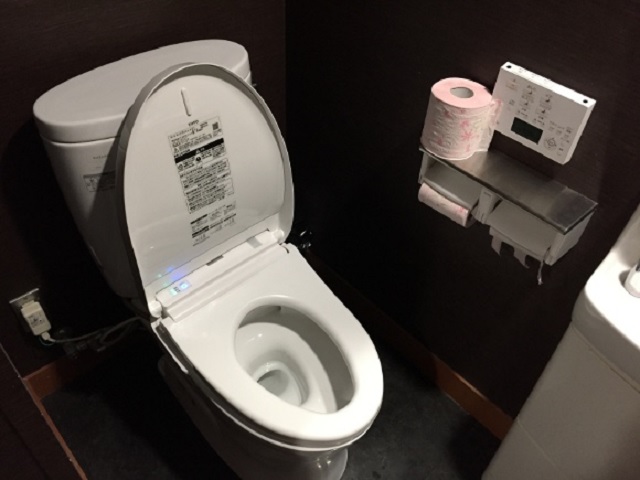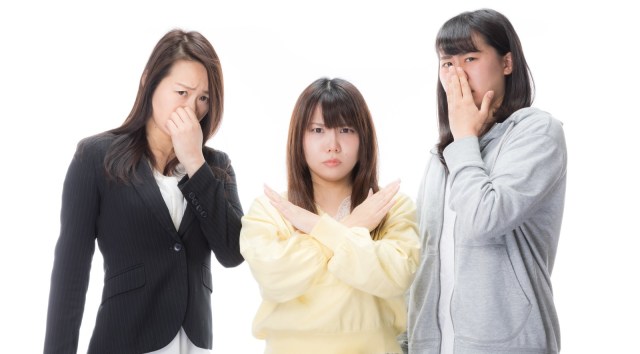
Over 60-percent gap between most and least accepting demographics.
Japanese Internet portal Sirabee regularly polls its users on a variety of topics, and one of its most recent was about toilets. Specifically, the poll’s organizers wanted to know how people feel about unisex restrooms.
In total, 1,798 responses were collected from men and women ranging in age from 10 to 69, and a slim majority of the respondents, 52.1 percent, are OK with the idea of unisex bathrooms. That leaves 47.9 percent that said they don’t want to use them, but the rate of resistance was far higher in certain demographics.
Overall, men were much more open to the concept, with less than 30 percent opposed in all age groups, and that number even starting to dip a little for more advanced ages.
Percentage of men who don’t want to use a unisex restroom
● Age 10-19: 16.8 percent
● Age 20-29: 21.2 percent
● Age 30-39: 24 percent
● Age 40-49: 28.7 percent
● Age 50-59; 28.5 percent
● Age 60-69: 27.6 percent
However, among women unisex bathrooms were seen as far less acceptable, with the majority of female respondents in all age groups saying they wouldn’t want to use one, and the idea especially repulsive to older ladies.
Percentage of women who don’t want to use a unisex restroom
● Age 10-19: 59.1 percent
● Age 20-29: 59.4 percent
● Age 30-39: 67.7 percent
● Age 40-49: 66.2 percent
● Age 50-59; 76.8 percent
● Age 60-69: 77.1 percent
While some might be quick to call this an example of less-than-progressive attitudes about gender identity in modern Japan, it’s worth bearing in mind that unisex public bathrooms have existed in the country for decades. However, most unisex restrooms in Japan owe their existence not to LGBT issues, but to space limits. Restaurants in Japan, especially inexpensive eateries and pubs, often try to cram as many tables as they can into a small interior, and instead of separate men’s and women’s bathrooms, simply have a few one-person unisex restrooms that can be accessed directly from an interior walkway, which can be used by any patron as long as they’re unoccupied.
In such cases, using a unisex bathroom doesn’t mean having to simultaneously share the use of a semi-secluded space with people of the opposite physical sex so much as possibly having to use the same stall right after such a person. Taking that into account, perhaps it’s not so surprising that such a large number of Japanese women aren’t too keen on using a unisex restroom, considering guys’ reputation for not being the most accurate with their aim when making liquid deposits (although perhaps if they knew how many Japanese men apparently like to sit down when taking a pee, they’d feel a little better).
Source: Sirabee via Niconico News via Jin
Top image ©SoraNews24
Insert image: Pakutaso
● Want to hear about SoraNews24’s latest articles as soon as they’re published? Follow us on Facebook and Twitter!


 Is it gross to eat sushi that the chef pressed with his bare hands?【Survey】
Is it gross to eat sushi that the chef pressed with his bare hands?【Survey】 Survey finds big gap in Japanese train passengers who want to sit next to someone of opposite sex
Survey finds big gap in Japanese train passengers who want to sit next to someone of opposite sex Majority of Japanese men in their 20s say they want men-only train cars in survey
Majority of Japanese men in their 20s say they want men-only train cars in survey Nearly half of young Japanese women say they “hate” the company they work for in survey
Nearly half of young Japanese women say they “hate” the company they work for in survey Is it OK to split the bill on a date in Japan? Survey asks what women and men of different ages think
Is it OK to split the bill on a date in Japan? Survey asks what women and men of different ages think Red light district sushi restaurant in Tokyo shows us just how wrong we were about it
Red light district sushi restaurant in Tokyo shows us just how wrong we were about it Japan’s massive matcha parfait weighs 6 kilos, contains hidden surprises for anyone who eats it
Japan’s massive matcha parfait weighs 6 kilos, contains hidden surprises for anyone who eats it Pokémon Sleep camping suite and guestrooms coming to Tokyo Hyatt along with giant Snorlax burgers
Pokémon Sleep camping suite and guestrooms coming to Tokyo Hyatt along with giant Snorlax burgers Beautiful Red and Blue Star luxury trains set to be Japan’s new Hokkaido travel stars
Beautiful Red and Blue Star luxury trains set to be Japan’s new Hokkaido travel stars McDonald’s new Happy Meals offer up cute and practical Sanrio lifestyle goods
McDonald’s new Happy Meals offer up cute and practical Sanrio lifestyle goods Historical figures get manga makeovers from artists of Spy x Family, My Hero Academia and more
Historical figures get manga makeovers from artists of Spy x Family, My Hero Academia and more Limited-edition Carbonara Udon will anger noodle purists and pasta lovers 【Taste test】
Limited-edition Carbonara Udon will anger noodle purists and pasta lovers 【Taste test】 Japanese ramen restaurants under pressure from new yen banknotes
Japanese ramen restaurants under pressure from new yen banknotes Anime girl English teacher Ellen-sensei becomes VTuber/VVTUber and NFT
Anime girl English teacher Ellen-sensei becomes VTuber/VVTUber and NFT We tried Korea’s way-too-big King Tonkatsu Burger at Lotteria 【Taste Test】
We tried Korea’s way-too-big King Tonkatsu Burger at Lotteria 【Taste Test】 All-you-can-drink Starbucks and amazing views part of Tokyo’s new 170 meter-high sky lounge
All-you-can-drink Starbucks and amazing views part of Tokyo’s new 170 meter-high sky lounge French Fries Bread in Tokyo’s Shibuya becomes a hit on social media
French Fries Bread in Tokyo’s Shibuya becomes a hit on social media Studio Ghibli releases new action figures featuring Nausicaä of the Valley of the Wind characters
Studio Ghibli releases new action figures featuring Nausicaä of the Valley of the Wind characters New private rooms on Tokaido Shinkansen change the way we travel from Tokyo to Kyoto
New private rooms on Tokaido Shinkansen change the way we travel from Tokyo to Kyoto Studio Ghibli glasses cases let anime characters keep an eye on your spectacles
Studio Ghibli glasses cases let anime characters keep an eye on your spectacles Tokyo Tsukiji fish market site to be redeveloped with 50,000-seat stadium, hotel, shopping center
Tokyo Tsukiji fish market site to be redeveloped with 50,000-seat stadium, hotel, shopping center Beautiful Ghibli sealing wax kits let you create accessories and elegant letter decorations【Pics】
Beautiful Ghibli sealing wax kits let you create accessories and elegant letter decorations【Pics】 Studio Ghibli releases Kiki’s Delivery Service chocolate cake pouches in Japan
Studio Ghibli releases Kiki’s Delivery Service chocolate cake pouches in Japan New definition of “Japanese whiskey” goes into effect to prevent fakes from fooling overseas buyers
New definition of “Japanese whiskey” goes into effect to prevent fakes from fooling overseas buyers Our Japanese reporter visits Costco in the U.S., finds super American and very Japanese things
Our Japanese reporter visits Costco in the U.S., finds super American and very Japanese things Studio Ghibli unveils Mother’s Day gift set that captures the love in My Neighbour Totoro
Studio Ghibli unveils Mother’s Day gift set that captures the love in My Neighbour Totoro New Japanese KitKat flavour stars Sanrio characters, including Hello Kitty
New Japanese KitKat flavour stars Sanrio characters, including Hello Kitty More foreign tourists than ever before in history visited Japan last month
More foreign tourists than ever before in history visited Japan last month New Pokémon cakes let you eat your way through Pikachu and all the Eevee evolutions
New Pokémon cakes let you eat your way through Pikachu and all the Eevee evolutions Sales of Japan’s most convenient train ticket/shopping payment cards suspended indefinitely
Sales of Japan’s most convenient train ticket/shopping payment cards suspended indefinitely Sold-out Studio Ghibli desktop humidifiers are back so Totoro can help you through the dry season
Sold-out Studio Ghibli desktop humidifiers are back so Totoro can help you through the dry season Japanese government to make first change to romanization spelling rules since the 1950s
Japanese government to make first change to romanization spelling rules since the 1950s Ghibli founders Toshio Suzuki and Hayao Miyazaki contribute to Japanese whisky Totoro label design
Ghibli founders Toshio Suzuki and Hayao Miyazaki contribute to Japanese whisky Totoro label design Doraemon found buried at sea as scene from 1993 anime becomes real life【Photos】
Doraemon found buried at sea as scene from 1993 anime becomes real life【Photos】 Tokyo’s most famous Starbucks is closed
Tokyo’s most famous Starbucks is closed One Piece characters’ nationalities revealed, but fans have mixed opinions
One Piece characters’ nationalities revealed, but fans have mixed opinions We asked a Uniqlo employee what four things we should buy and their suggestions didn’t disappoint
We asked a Uniqlo employee what four things we should buy and their suggestions didn’t disappoint Princesses, fruits, and blacksmiths: Study reveals the 30 most unusual family names in Japan
Princesses, fruits, and blacksmiths: Study reveals the 30 most unusual family names in Japan How often do Japanese people rip silent farts? Survey investigates
How often do Japanese people rip silent farts? Survey investigates Which jobs in Japan have the most and least overtime? Survey investigates
Which jobs in Japan have the most and least overtime? Survey investigates Does a guy lose all chance with a Japanese woman if he doesn’t pay for the first date?【Survey】
Does a guy lose all chance with a Japanese woman if he doesn’t pay for the first date?【Survey】 Young Japanese men say paying for dates is the hardest part of life as a guy【Survey】
Young Japanese men say paying for dates is the hardest part of life as a guy【Survey】 Survey asks which country’s fashion is the most influential in Japanese street style
Survey asks which country’s fashion is the most influential in Japanese street style Japanese dating site’s picture of ideally attractive woman: young, no sleeves, college education
Japanese dating site’s picture of ideally attractive woman: young, no sleeves, college education Survey asks Japanese women if they could marry a man who’s rich but ugly
Survey asks Japanese women if they could marry a man who’s rich but ugly How should a guy say “I” in Japanese? Japanese women give their opinions【Survey】
How should a guy say “I” in Japanese? Japanese women give their opinions【Survey】 Super Mario meets Gelato Pique in Japan’s coziest and latest loungewear sets
Super Mario meets Gelato Pique in Japan’s coziest and latest loungewear sets Hyper-detailed anime girl masks are here to solve, possibly create your fashion problems【Photos】
Hyper-detailed anime girl masks are here to solve, possibly create your fashion problems【Photos】 More than one in three Japanese working women in survey would rather be housewives
More than one in three Japanese working women in survey would rather be housewives Tokyo entertainment complex remodels restroom to remove gender-neutral setup
Tokyo entertainment complex remodels restroom to remove gender-neutral setup Only one demographic in survey is happy about Japan’s workplace obligation Valentine’s chocolate
Only one demographic in survey is happy about Japan’s workplace obligation Valentine’s chocolate Survey reveals Japan’s Generation Z dresses for social media, not for self-expression
Survey reveals Japan’s Generation Z dresses for social media, not for self-expression New gachapon figures from Japan imagine a romance beyond bathroom boundaries
New gachapon figures from Japan imagine a romance beyond bathroom boundaries Majority of younger Japanese people in survey respect less than 30 percent of their old coworkers
Majority of younger Japanese people in survey respect less than 30 percent of their old coworkers
Leave a Reply